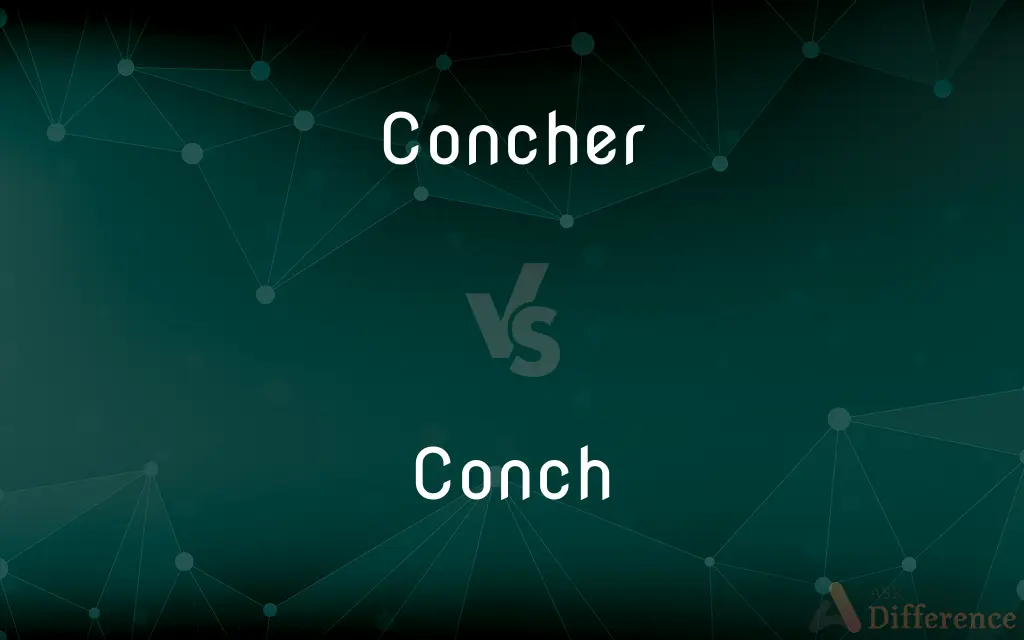Concher vs. Conch — What's the Difference?
Edited by Tayyaba Rehman — By Maham Liaqat — Updated on April 27, 2024
Conchers are specialized machines used in chocolate production to refine texture and flavor, whereas a conch refers to a type of sea snail known for its distinctively shaped shell.

Difference Between Concher and Conch
Table of Contents
ADVERTISEMENT
Key Differences
Conchers play a crucial role in the chocolate manufacturing process, smoothing chocolate's texture and enhancing its flavor through aeration and heat. On the other hand, conches are marine mollusks, notable for their spiral shells that are often collected for decorative purposes or used as wind instruments.
The operation of a concher involves mechanical stirring and grinding of chocolate mass, which reduces particle sizes and distributes cocoa butter evenly. Whereas, conches live in tropical waters and are part of the marine ecosystem, contributing to the biological diversity and sometimes influencing local economies through shell collection.
Conchers are typically large, industrial machines that require significant capital investment and are used in factories. In contrast, conches can be found along beaches and coastal areas, making them accessible to the general public for collection and observation.
While conchers are essential for achieving the desired texture and flavor in high-quality chocolate, conches are often sought after by collectors and artisans for their beautiful shells that are used in crafts and jewelry.
In terms of economic impact, conchers are vital for the chocolate industry, affecting the quality and production efficiency of chocolate products. Conversely, conches have cultural and economic significance in certain regions, where they are used in craft making or sold as souvenirs.
ADVERTISEMENT
Comparison Chart
Type
Machine
Sea snail
Use
Refines chocolate
Decorative, musical
Location
Factories
Oceans, particularly tropical
Function
Enhances texture and flavor of chocolate
Part of marine biodiversity, cultural significance
Economic Impact
Crucial for chocolate industry
Tourism and crafts in some regions
Compare with Definitions
Concher
A machine used in the chocolate industry to smooth and refine chocolate mass.
The concher ran for several hours to ensure the chocolate's silky texture.
Conch
Can be blown as a horn in some cultures.
The fisherman used a conch shell to signal his return to shore.
Concher
A device in chocolate production that aerates chocolate mass.
The concher's role is critical in developing the chocolate's final flavor profile.
Conch
Often used as a decorative item or in jewelry.
The conch shells were polished and sold as home decor.
Concher
Industrial equipment for chocolate texture and flavor enhancement.
Our new concher has significantly improved our chocolate's quality.
Conch
Symbolic in various cultures, representing the ocean's beauty and mystery.
In local mythology, the conch represents maritime strength and resilience.
Concher
Used to homogenize chocolate ingredients.
Adding the milk powder before the concher process helps in its integration.
Conch
A marine mollusk known for its spiral shell.
She picked up a large conch from the beach during low tide.
Concher
Key in reducing particle size in chocolate.
The concher helps achieve the smooth consistency demanded by premium chocolates.
Conch
Part of the diet in many coastal communities.
Conch fritters are a popular dish in Caribbean cuisine.
Concher
A machine (rather like a rotating pestle and mortar) used to refine the flavour and texture of chocolate by warming and grinding.
Conch
Conch () is a common name of a number of different medium-to-large-sized sea snails. Conch shells typically have a high spire and a noticeable siphonal canal (in other words, the shell comes to a noticeable point at both ends).
Concher
A person who operates such a machine.
Conch
Any of various tropical marine gastropod mollusks chiefly of the family Strombidae, having edible flesh and a large spiral shell often with a flared lip.
Conch
The shell of one of these gastropod mollusks, used as an ornament, in making cameos, or as a horn.
Conch
(Anatomy) See concha.
Conch
A marine gastropod of the family Strombidae which lives in its own spiral shell.
Conch
The shell of this sea animal.
Conch
A musical instrument made from a large spiral seashell, somewhat like a trumpet.
Conch
(architecture) The semidome of an apse, or the apse itself.
Conch
Synonym of concher
Conch
To refine the flavour and texture of chocolate by warming and grinding, either in a traditional concher, or between rollers.
Conch
To play a conch seashell as a musical instrument, by blowing through a hole made close to the origin of the spiral.
Conch
A name applied to various marine univalve shells; esp. to those of the genus Strombus, which are of large size. Strombus gigas is the large pink West Indian conch. The large king, queen, and cameo conchs are of the genus Cassis. See Cameo and cameo conch.
Conch
In works of art, the shell used by Tritons as a trumpet.
Conch
One of the white natives of the Bahama Islands or one of their descendants in the Florida Keys; - so called from the commonness of the conch there, or because they use it for food.
Conch
Any of various edible tropical marine gastropods of the genus Strombus having a brightly-colored spiral shell with large outer lip
Common Curiosities
What cultural significance do conches have?
Conches are used in many cultures for decorative purposes, in crafts, or as musical instruments.
What is the primary use of a concher?
Conchers are used in chocolate production to improve the texture and flavor of chocolate.
What part of the conch is most commonly used?
The shell of the conch is the most commonly utilized part, especially for decorative and musical purposes.
Are conches important to marine ecosystems?
Yes, conches are part of marine biodiversity and contribute to the ecological balance of their habitats.
How does a concher affect chocolate quality?
A concher enhances chocolate's smoothness and flavor through heat and aeration.
Where can one typically find a conch?
Conches are typically found in tropical and subtropical oceans, often on sandy shores.
How long does a conching process take?
The conching process can last between a few hours to several days, depending on the desired chocolate quality.
What is the typical habitat of a conch?
Conches live in marine environments, particularly in warm, shallow waters.
Can conchers be used for any chocolate type?
Yes, conchers are used for refining various types of chocolate, including dark, milk, and white chocolate.
What materials are conchers made from?
Conchers are typically made from durable metals like stainless steel to withstand the mechanical and thermal stresses involved in chocolate refining.
How does the conch shell's shape benefit the animal?
The conch shell's spiral shape helps protect the animal from predators and rough environmental conditions.
Are conchers and conches related in any way?
No, conchers and conches are unrelated; one is a machine used in chocolate production, and the other is a sea snail.
Can conch shells be used for anything besides decoration?
Yes, conch shells are also used as musical instruments and in traditional crafts.
Is it legal to collect conches everywhere?
Collecting conches may be restricted in some areas to protect local biodiversity and prevent overharvesting.
What are the environmental considerations of using conchers?
Conchers require energy to operate, so energy efficiency and sourcing from renewable resources are important environmental considerations.
Share Your Discovery

Previous Comparison
Squirm vs. Wiggle
Next Comparison
Genius vs. TalentAuthor Spotlight
Written by
Maham LiaqatEdited by
Tayyaba RehmanTayyaba Rehman is a distinguished writer, currently serving as a primary contributor to askdifference.com. As a researcher in semantics and etymology, Tayyaba's passion for the complexity of languages and their distinctions has found a perfect home on the platform. Tayyaba delves into the intricacies of language, distinguishing between commonly confused words and phrases, thereby providing clarity for readers worldwide.














































